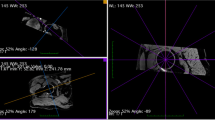Abstract
The purpose of this study was to evaluate the validity and reliability of a radiographic diagnosis of femoroacetabular impingement (FAI) by a non-radiologist. Symptomatic FAI is prevalent and thought to be a cause of hip osteoarthritis. However, the diagnosis is often delayed by 1–2 years, in large part because radiographic findings are often subtle and clinicians have been unaware of their significance. The purpose of this study was to evaluate the validity of a radiographic diagnosis of FAI by a non-radiologist. A population-based sample of 701 subjects was recruited in Vancouver, Canada. For the current study, 50 subjects were selected—40 randomly from the population sample and 10 from an orthopedic practice with confirmed FAI. An anterior–posterior pelvis and bilateral Dunn radiographs were acquired and read by a fellowship-trained musculoskeletal radiologist and a third-year medical student who received basic training in radiographic signs of FAI. Three radiographic signs were evaluated: the lateral center edge angle, alpha angle and crossover sign. Validity was assessed using sensitivity and specificity, Bland–Altman limits of agreement and kappa. The sample contained 65 % women (n = 31), was 62 % Caucasian and 38 % Chinese and had a mean age of 38.3 years. For correctly diagnosing FAI, the non-radiologist reader had a sensitivity of 0.83 and specificity of 0.87. Intra-rater κ value was 0.72, and prevalence-adjusted bias-adjusted κ was 0.76. This study provides evidence that a non-radiologist can accurately and reliably identify FAI on plain films.





Similar content being viewed by others
References
Ganz R, Parvizi J, Beck M, Leunig M, Notzli H, Siebenrock KA (2003) Femoroacetabular impingement: a cause for osteoarthritis of the hip. Clin Orthop Relat Res 417:112–120
Nicholls AS, Kiran A, Pollard TC, Hart DJ, Arden CP, Spector T, Gill HS, Murray DW, Carr AJ, Arden NK (2011) The association between hip morphology parameters and nineteen-year risk of end-stage osteoarthritis of the hip: a nested case-control study. Arthritis Rheum 63(11):3392–3400. doi:10.1002/art.30523
Jung KA, Restrepo C, Hellman M, Abdelsalam H, Parvizi J, Morrison W (2011) The prevalence of cam-type femoroacetabular deformity in asymptomatic adults. J Bone Joint Surg Br 93(10):1303–1307
Ochoa LM, Dawson L, Patzkowski JC, Hsu JR (2010) Radiographic prevalence of femoroacetabular impingement in a young population with hip complaints is high. Clin Orthop Relat Res 468(10):2710–2714. doi:10.1007/s11999-010-1233-8
Gosvig KK, Jacobsen S, Sonne-Holm S, Palm H, Troelsen A (2010) Prevalence of malformations of the hip joint and their relationship to sex, groin pain, and risk of osteoarthritis: a population-based survey. J Bone Joint Surg Am 92(5):1162–1169. doi:10.2106/JBJS.H.01674
Clohisy JC, Knaus ER, Hunt DM, Lesher JM, Harris-Hayes M, Prather H (2009) Clinical presentation of patients with symptomatic anterior hip impingement. Clin Orthop Relat Res 467(3):638–644
Philippon MJ, Maxwell RB, Johnston TL, Schenker M, Briggs KK (2007) Clinical presentation of femoroacetabular impingement. Knee Surg Sports Traumatol Arthrosc 15(8):1041–1047
Carlisle JC, Zebala LP, Shia DS, Hunt D, Morgan PM, Prather H, Wright RW, Steger-May K, Clohisy JC (2011) Reliability of various observers in determining common radiographic parameters of adult hip structural anatomy. Iowa Orthop J 31:52–58
Jaberi FM, Parvizi J (2007) Hip pain in young adults: femoroacetabular impingement. J Arthroplasty 22(7 Suppl 3):37–42
Tannast M, Siebenrock KA, Anderson SE (2007) Femoroacetabular impingement: radiographic diagnosis–what the radiologist should know. AJR Am J Roentgenol 188(6):1540–1552
Meyer DC, Beck M, Ellis T, Ganz R, Leunig M (2006) Comparison of six radiographic projections to assess femoral head/neck asphericity. Clin Orthop Relat Res 445:181–185. doi:10.1097/01.blo.0000201168.72388.24
Wiberg G (1939) Studies on dysplastic acetabula and congenital subluxation of the hip joint: with special reference to the complication of osteoarthritis. Acta Chir Scand 83(suppl 58):1–135
Reynolds D, Lucas J, Klaue K (1999) Retroversion of the acetabulum. A cause of hip pain. J Bone Joint Surg Br 81(2):281–288
Notzli HP, Wyss TF, Stoecklin CH, Schmid MR, Treiber K, Hodler J (2002) The contour of the femoral head-neck junction as a predictor for the risk of anterior impingement. J Bone Joint Surg Br 84(4):556–560
Bland JM, Altman DG (1986) Statistical methods for assessing agreement between two methods of clinical measurement. Lancet 1(8476):307–310
Mast NH, Impellizzeri F, Keller S, Leunig M (2011) Reliability and agreement of measures used in radiographic evaluation of the adult hip. Clin Orthop Relat Res 469(1):188–199. doi:10.1007/s11999-010-1447-9
Thomas GE, Hart DA, Spector T, Glyn-Jones S et al (2012) The association between hip morphology and end-stage osteoarthritis at 12-year follow up. Osteoarthr Cartil 20(Supp 1):S204
Jamali AA, Mladenov K, Meyer DC, Martinez A, Beck M, Ganz R, Leunig M (2007) Anteroposterior pelvic radiographs to assess acetabular retroversion: high validity of the “cross-over-sign”. J Orthop Res 25(6):758–765
Barton C, Salineros MJ, Rakhra KS, Beaule PE (2011) Validity of the alpha angle measurement on plain radiographs in the evaluation of cam-type femoroacetabular impingement. Clin Orthop Relat Res 469(2):464–469. doi:10.1007/s11999-010-1624-x
Tannast M, Mistry S, Steppacher SD, Reichenbach S, Langlotz F, Siebenrock KA, Zheng G (2008) Radiographic analysis of femoroacetabular impingement with Hip2Norm-reliable and validated. J Orthop Res 26(9):1199–1205
Acknowledgments
The protocol for this study was approved by the Clinical Research Ethics Board at the University of British Columbia. This study was supported by the Canadian Institutes of Health Research (107513).
Author information
Authors and Affiliations
Corresponding author
Ethics declarations
Conflict of interest
None.
Rights and permissions
About this article
Cite this article
Ratzlaff, C., Zhang, C., Korzan, J. et al. The validity of a non-radiologist reader in identifying cam and pincer femoroacetabular impingement (FAI) using plain radiography. Rheumatol Int 36, 371–376 (2016). https://doi.org/10.1007/s00296-015-3361-7
Received:
Accepted:
Published:
Issue Date:
DOI: https://doi.org/10.1007/s00296-015-3361-7




